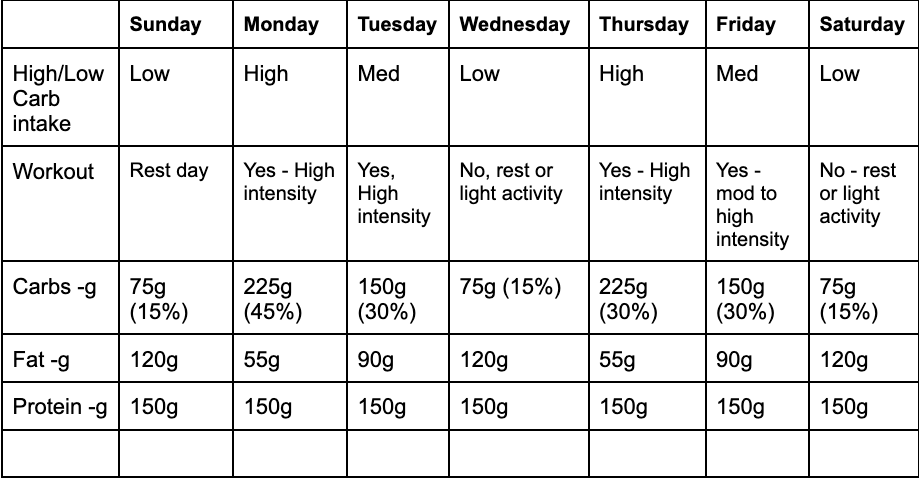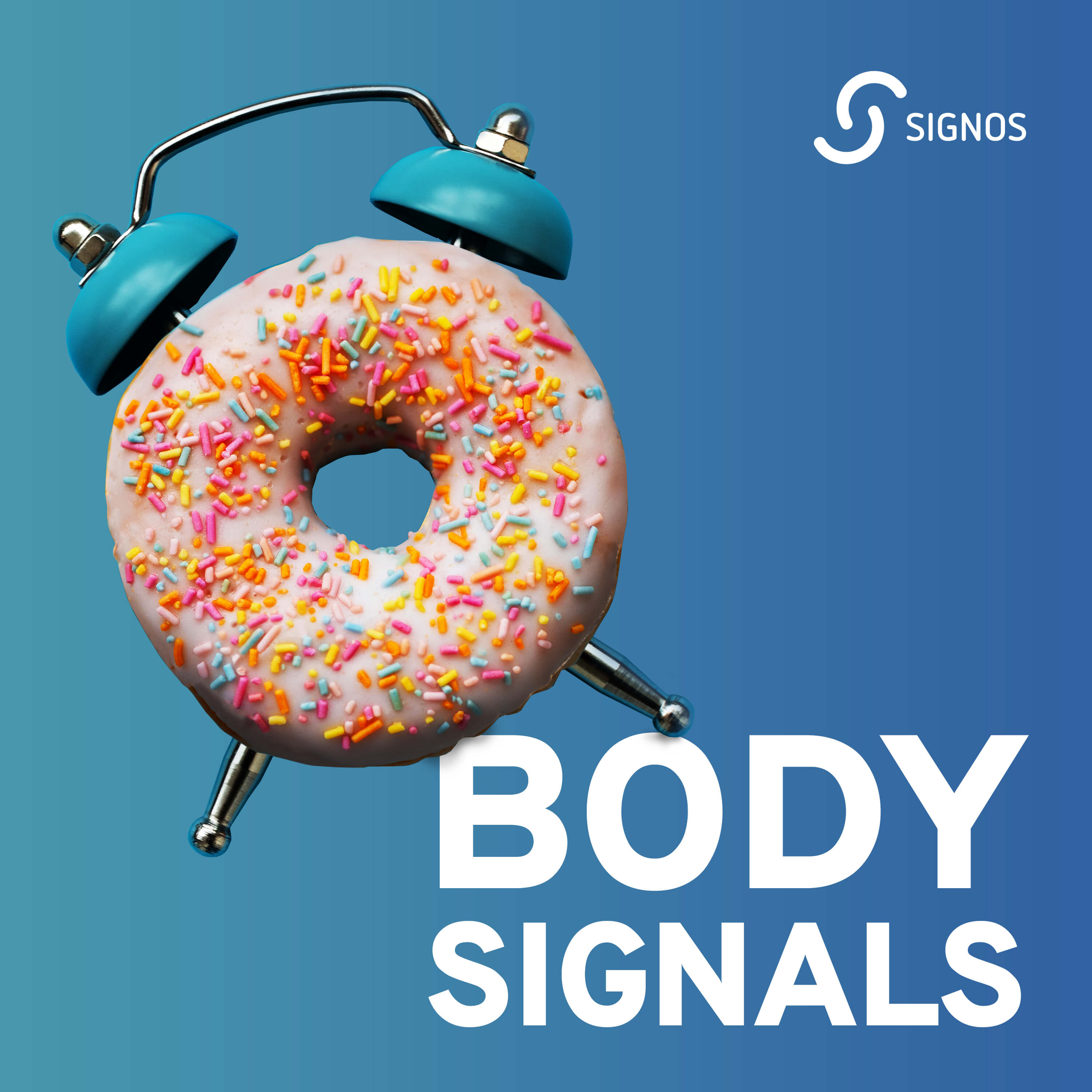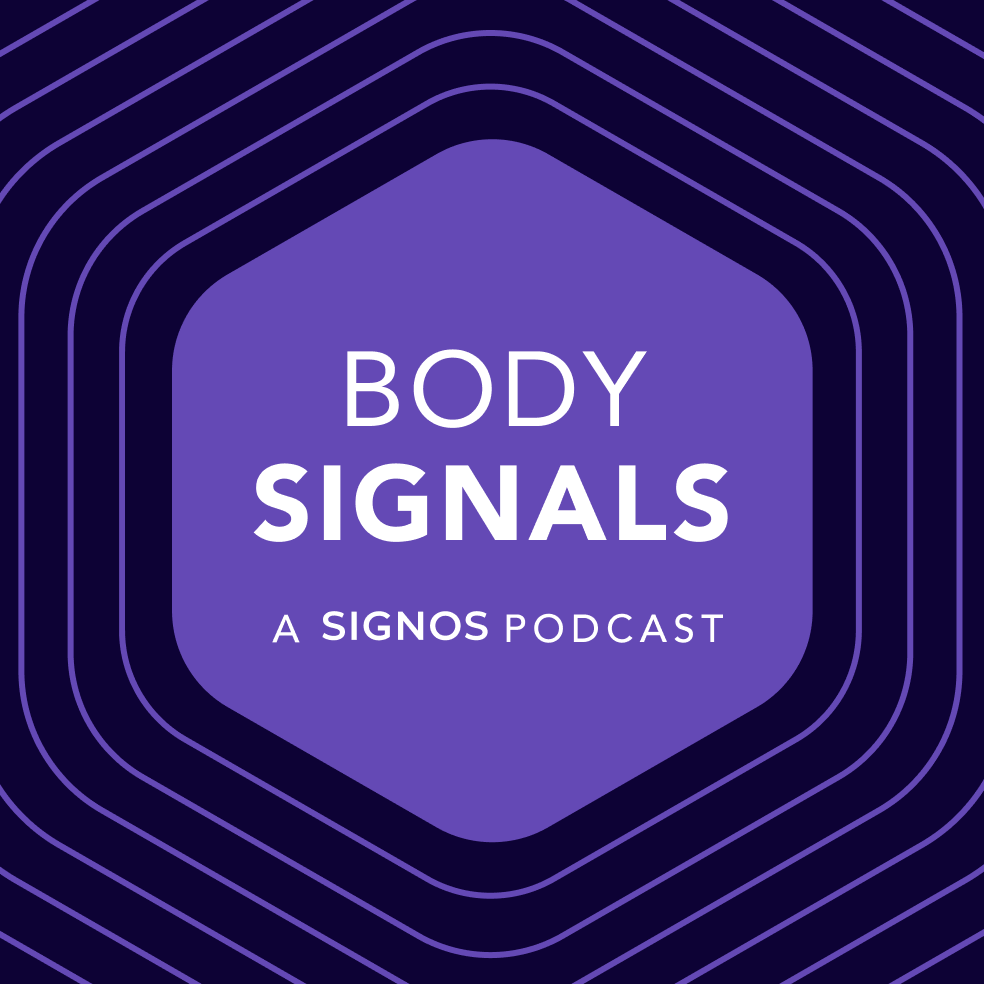Carb cycling is an emerging diet trend where carbohydrates are eaten at certain times of the day or week to help improve performance and is now being looked at as a way to help with weight loss and blood sugar control.
What may have started more generally as nutrient timing for athletic performance carb cycling seems to be making its way into other functional areas like weight loss and body composition improvement.
We’ll look at what the science says about carb cycling, what, if any, benefits there are, how it is used for weight loss, and what foods you should focus on if you try it.
What is a Carb Cycling Diet and How Does It Work?
Carb cycling is simply adjusting your carb intake over a month, week, or day to target different effects in your body. While there is little scientific research to back it up, carb cycling is being touted for fat loss, weight loss, and improved athletic performance.
But let’s take a step back. What are carbohydrates, and why are they necessary? Carbohydrates are starches and sugars that are broken down into glucose to give our body and organs energy or fuel to work.
We need carbs to fuel our brains, give our lungs energy to breathe, and our heart energy to pump blood. Whether you are an athlete, a casual exerciser, or just want energy to complete your daily activities, carbs are essential to help fuel your muscles. If you eat extra, well, that gets stored in your muscles as glycogen. We pull from those stores to stabilize our blood sugar and muscles when we have lower amounts.
Carbs have been a key focus in the weight loss industry for a while now and are often vilified. But this new trend of carb-cycling focuses more on eating them at specific intervals to help improve your performance and stimulate weight loss, rather than excluding or severely restricting them.
Athletes often focus on eating specific nutrients at specific times to help with their performance, and carbs are often the focus.1
- Long-distance runners often “carb load” the night before a long run to build up their muscle glycogen stores.
- Those working on lowering their body fat stores may limit carbs to lose body fat and then add them back right before a performance.
- Others will limit them until after their competition and then use them to help with recovery.
{{mid-cta}}
Does Carb Cycling Actually Work? The Science Behind Carb Cycling
While athletes typically use carb cycling to improve performance, there is very little evidence to suggest that cycling carbs as part of a weight loss plan can improve weight loss over calorie restriction alone.
One study in England compared calorie restriction alone to calorie restriction plus two days of carbohydrate restriction or two days of carb restriction with an unlimited protein and fat diet. After three months, the two carb-restricted groups returned to a normal eating pattern but restricted carbs one day a week. Both carb-restricted groups had improved insulin sensitivity and significantly reduced body fat. However, the groups did not differ in body weight, waist circumference, or lipid levels.2
While weight loss is a question mark, some small studies have shown that carb cycling may be helpful for bodybuilders. In some research, those that included carb loading pre-competition saw improved muscle volume and appearance before a performance.3
Key Benefits of Carb Cycling
Carb cycling allows individuals to adjust the number of carbohydrates ingested to coincide with the times when the body can utilize them. It is an approach used by athletes and individuals trying to lose weight or overcome a plateau along their weight-loss journey.
While the jury is still out on the effectiveness of carb cycling, there are some potential benefits.
May support weight loss and fat loss
Low carbohydrate and high protein diets like the keto diet have become popular for weight loss. While some research supports their short-term effectiveness, there needs to be more evidence that they are effective over the long term.4,5 Additionally, many find them difficult to follow over the long haul.
So the question remains, does adjusting your carb intake to times of high activity will help spur increased weight and fat loss? Possibly. Any time you consume fewer calories than your body burns, you will lose weight. Some people find adding carb-cycling to a low-calorie diet can help. Having low and high-carb days gives more flexibility and keeps some people from feeling deprived.
One small study found that the individuals who followed a diet that intermittently restricted calories while lowering their carbohydrate consumption had greater weight loss than those who just followed a calorie-restricted diet.2
May optimize performance
The International Society of Sports Nutrition (ISSN) issued a position in 2017 that nutrient timing may help enhance recovery and tissue repair, assist with muscle protein synthesis, and improve mood following high-intensity exercise.6
Some research suggests carbohydrates during resistance training may help improve glycogen stores and ease muscle damage. However, research on carb-cycling is conflicting. Results between carb-cycling and strength training effects have not been clear-cut, leading the researchers to suggest much more research is needed.7

May positively impact hormones
There is some evidence that carb cycling may affect the hormones associated with appetite regulation (leptin and ghrelin) and insulin, the hormone that helps regulate blood glucose levels.
Ghrelin is a hormone that stimulates the appetite. It is typically released before eating and falls after eating. Some evidence suggests that a high carbohydrate and high protein diet helps diminish ghrelin levels, but more research is needed.8
Leptin is often referred to as the satiety hormone, helping with long-term energy balance, and higher levels may increase energy expenditure while reducing appetite. A small study found a higher ratio of leptin to ghrelin after ingesting high-carb meals in normal-weight men compared to overweight men suggesting carbohydrates may play a role in both hormone levels in some people but not all.9
May improve insulin sensitivity
Leptin may also have a role in improving insulin sensitivity and increasing glucose utilization and uptake. Much of this research has been done in animals and has yet to be seen in humans, so more work is needed to understand the hormonal effects of diet cycling on metabolism and overall health.10
Keep in mind there are only a few very small studies, and while we can infer some benefits from other research, there is very little data to support any long-term benefit from carb cycling.
How to Do Carb Cycling for Weight Loss
Successful long-term weight loss is difficult for many people to achieve. Calorie-restricted diets are often hard to follow over a long period, and the same goes for highly restricted diets like the ketogenic or paleo diet. However, when a reduced-calorie diet is combined with carb cycling, this could be an option that makes it easier.
With this type of eating style, some days can be higher in carbs while others are low. This allows for more flexibility and decreases the feelings of diet restriction.
When you are carb cycling, your carbohydrate intake is higher on days filled with more activity or high-intensity workouts and lower on rest days.
There are many variations to carb cycling schedules and plans and it is best to meet with a registered dietitian who can help develop a plan that will meet your individual needs.
While there are many variations and there isn’t a “one-size fit’s all” for a carb-cycling plan, here’s an example of what a week may look like for someone who exercises four days a week with two high-intensity workouts and eats about 2000 calories a day:

Example Carb Cycling Meal Plan
That’s all well and good, but how does that chart translate to real meals? What’s an example of a carb-cycling meal plan?
Here are some examples of what you might eat on low-carb, medium-carb, and high-carb days.
Low Carb Day
Breakfast
- 2 scrambled eggs, scrambled with healthy fats like grapeseed, avocado, or olive oil
- 2 turkey sausage patties
- 1 cup whole milk
Mid-Morning Snack
- ¼ cup mixed nuts with ¼ cup roasted chickpeas
Lunch
- 3 chicken salad lettuce wraps made with 4 oz. chicken breast, celery, cucumber, onion, and mayonnaise with diced tomatoes.
- 1 glass of unsweetened iced tea with lemon juice
Mid-Afternoon Snack
- 1 protein shake
Dinner
- 1, 6 oz. salmon fillet
- ½ cup brown rice
- 1 cup mixed vegetables
Moderate Carb Day
Breakfast
- 2 scrambled eggs
- 2 turkey sausage patties
- 2 slices whole-grain toast with butter
Mid-Morning Snack
- 1 apple
- 1 tablespoon peanut butter
Lunch
- 1 salad with tuna
- 3 cups lettuce
- 4 oz tuna in extra virgin olive oil
- ¼ cup red onion
- ¼ cup diced red pepper
- 1 glass of unsweetened iced tea with lemon juice
Mid-Afternoon Snack
- 1 protein shake
- 1 cup popcorn
Dinner
- 1, 6 oz. broiled pork chop with mango salsa
- ½ cup quinoa
- 1 cup asparagus spears
Evening snack
- 1 cup of kefir
High Carb Day
Breakfast
- Mango pineapple smoothie with kefir and chia seeds
Mid-Morning Snack
- ¼ cup mixed nuts
Lunch
- 1 turkey sandwich with whole grain bread, lettuce, tomatoes, and cucumber
- 1 apple
- 1 glass of unsweetened iced tea with lemon juice
Mid-Afternoon Snack
- 1 protein shake
Dinner
- 6 oz. shrimp
- 1 cup diced tomatoes with ¼ cup onion and garlic with Italian seasoning
- 2 cups whole grain pasta, cooked
- 1 cup spinach and kale salad with feta cheese and balsamic vinaigrette
Evening Snack
- Dark chocolate oatmeal protein balls with peanut butter

Good Carbohydrate Food Sources
So, does this mean you can pile on the cereal and pasta on your high-carb days? And what types of carbs will give you the most bang for your buck on your lower-carb days?
While higher-carb days are maybe a bit easier, there are foods that are a better nutritional choice. On the other hand, low-carb days require even more of a laser focus on what you are eating to ensure you get the nutrients you need to support your weight loss goals and your overall metabolic health.
Fruits
Fruit is rich in fiber, vitamins and minerals, and antioxidants that help support your overall metabolic health. While most contain purely carbohydrates and anywhere from 15g to 30g per serving, they are also a good source of fiber that will help keep your blood sugar in check. Aim for at least one serving daily on your low-carb days and two or more on your moderate and higher-carb days.
Vegetables
Rich in heart-healthy fiber, antioxidants, vitamins, and minerals, vegetables should be included a few times a day. They are low in calories and can range in carbohydrate content, ranging from 1g per serving up to 15g- 30g in a starchy vegetable like corn or potatoes.
Eating more leafy greens, broccoli, cauliflower, and peppers will keep you in the lower range but go ahead and work in some of the higher carb choices on the days you can. They are filled with nutrients like potassium and fiber and should be included in your meal plans.
You should be aiming for 3 - 5 servings of vegetables a day.
Whole grains
Grains like brown rice, barley, 100% whole grain bread and pasta, and quinoa are incredibly healthy foods that should be included in all eating plans. Many like oatmeal and brown rice, have resistant starches that don’t get converted to sugar but are converted to butyrate, which helps fuel your microbiome and keeps your gut healthy.
Each serving provides about 15 g of carbs. Even on low-carb days, you should get a couple of servings of whole grains a day.
Legumes
The fiber-packed vegetables are also a good source of protein, with a ½ cup serving providing about 7-10g of protein per serving. While they also contain about 20 grams of carbohydrates, they are slow digesting and contain resistant starch. They are a great option for carbs and protein in your daily meal plan. One serving at least five days a week is a good idea.
Dairy
Because of their calcium and vitamin D content, dairy foods are a carb that should be included in a healthy diet. Many of these also contain protein - about 8g per cup. Just read the labels to limit added sugars and opt for choices like milk and plain kefir or Greek yogurt. One cup of milk has about 12g of carbs.
Is The Carb Cycling Diet Safe?
While there isn’t a “one-size fit’s all” approach to weight loss, finding a healthy, balanced approach to eating is typically the safest and most successful approach for long-term weight loss.11
As with restricted carb diets, some people may experience fatigue, moodiness, and sleep problems when following a carb cycling routine. Others have reported gastrointestinal issues, including bloating and constipation.
Carb cycling should not be encouraged or followed during pregnancy or breastfeeding or if someone has a history of an eating disorder.
It’s also a good idea to consult with your doctor before starting a restrictive eating plan, especially if you have a health condition or are taking medications. Working with a dietitian is a good idea to find the right protocol to meet your needs and ensure you get the nutrition you need.
Practical Tips to Master Carb Cycling
If you want to try carb-cycling, here are a few tips to help make it easier.
- Stock up on high-fiber fruits and vegetables
- Choose low-fat dairy products
- Add legumes to your routine
- Opt for whole grains over refined
- Limit high-sugar and fried foods
- Consult an expert
Learn More About Healthy Nutrition and Exercise with Signos’ Expert Advice.
If you are working on adopting healthier habits, hop over to our blog to learn more about different eating plans, nutrition, and exercise habits that may be helpful. While you’re there, read more about Signos and how it may be able to help improve your health. Want to see if it’s a good fit? Take this short quiz to learn more.
- Item 1
- Item 2
- item 3
Topics discussed in this article:
References
- Arent, S. M., Cintineo, H. P., McFadden, B. A., Chandler, A. J., & Arent, M. A. (2020). Nutrient Timing: A Garage Door of Opportunity? Nutrients, 12(7), 1948. https://doi.org/10.3390/nu12071948
- Harvie, M., Wright, C., Pegington, M., McMullan, D., Mitchell, E., Martin, B., . . . Howell, A. (2013). The effect of intermittent energy and carbohydrate restriction v. daily energy restriction on weight loss and metabolic disease risk markers in overweight women. British Journal of Nutrition, 110(8), 1534-1547. doi:10.1017/S0007114513000792
- de Moraes, W. M. A. M., de Almeida, F. N., Dos Santos, L. E. A., Cavalcante, K. D. G., Santos, H. O., Navalta, J. W., & Prestes, J. (2019). Carbohydrate Loading Practice in Bodybuilders: Effects on Muscle Thickness, Photo Silhouette Scores, Mood States and Gastrointestinal Symptoms. Journal of sports science & medicine, 18(4), 772–779.
- Pavlidou, E., Papadopoulou, S. K., Fasoulas, A., Mantzorou, M., & Giaginis, C. (2023). Clinical Evidence of Low-Carbohydrate Diets against Obesity and Diabetes Mellitus. Metabolites, 13(2), 240. https://doi.org/10.3390/metabo13020240
- Naude, C. E., Brand, A., Schoonees, A., Nguyen, K. A., Chaplin, M., & Volmink, J. (2022). Low-carbohydrate versus balanced-carbohydrate diets for reducing weight and cardiovascular risk. The Cochrane database of systematic reviews, 1(1), CD013334. https://doi.org/10.1002/14651858.CD013334.pub2
- Kerksick, C. M., Arent, S., Schoenfeld, B. J., Stout, J. R., Campbell, B., Wilborn, C. D., Taylor, L., Kalman, D., Smith-Ryan, A. E., Kreider, R. B., Willoughby, D., Arciero, P. J., VanDusseldorp, T. A., Ormsbee, M. J., Wildman, R., Greenwood, M., Ziegenfuss, T. N., Aragon, A. A., & Antonio, J. (2017). International society of sports nutrition position stand: nutrient timing. Journal of the International Society of Sports Nutrition, 14, 33. https://doi.org/10.1186/s12970-017-0189-4
- Henselmans, M., Bjørnsen, T., Hedderman, R., & Vårvik, F. T. (2022). The Effect of Carbohydrate Intake on Strength and Resistance Training Performance: A Systematic Review. Nutrients, 14(4), 856. https://doi.org/10.3390/nu14040856
- Gavrieli, A., & Mantzoros, C. S. (2016). Novel Molecules Regulating Energy Homeostasis: Physiology and Regulation by Macronutrient Intake and Weight Loss. Endocrinology and metabolism (Seoul, Korea), 31(3), 361–372. https://doi.org/10.3803/EnM.2016.31.3.361
- Adamska-Patruno, E., Ostrowska, L., Goscik, J., Pietraszewska, B., Kretowski, A., & Gorska, M. (2018). The relationship between the leptin/ghrelin ratio and meals with various macronutrient contents in men with different nutritional status: a randomized crossover study. Nutrition journal, 17(1), 118. https://doi.org/10.1186/s12937-018-0427-x
- Misch, M., & Puthanveetil, P. (2022). The Head-to-Toe Hormone: Leptin as an Extensive Modulator of Physiologic Systems. International journal of molecular sciences, 23(10), 5439. https://doi.org/10.3390/ijms23105439
- Koliaki, C., Spinos, T., Spinou, Μ., Brinia, Μ. E., Mitsopoulou, D., & Katsilambros, N. (2018). Defining the Optimal Dietary Approach for Safe, Effective and Sustainable Weight Loss in Overweight and Obese Adults. Healthcare (Basel, Switzerland), 6(3), 73. https://doi.org/10.3390/healthcare6030073


.jpg)





























